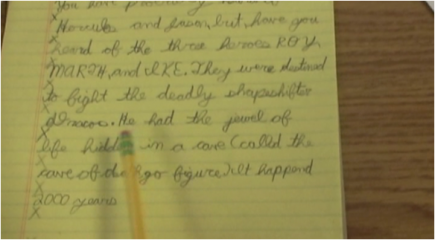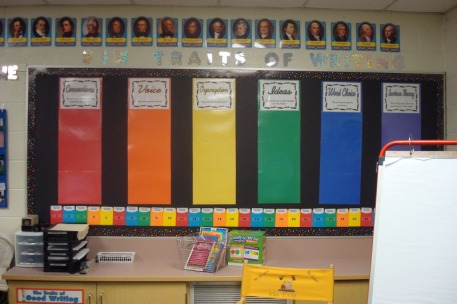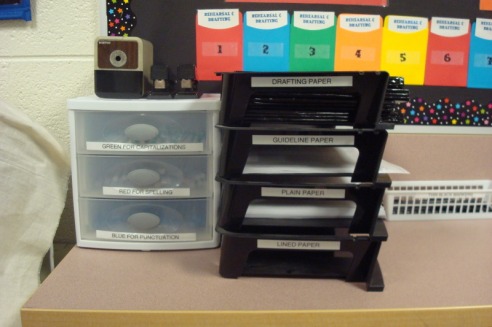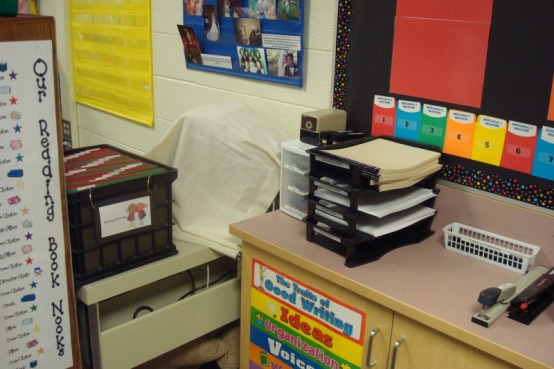Differentiation Made Easy:
Teaching with a Workshop Approach
Teaching with a Workshop Approach
Writer's Workshop
During writer's workshop time in my classroom, my minilessons for whole group instruction focuses on teaching the strategies for the six traits of writing. I also conference with my students one-on-one and they have a goal and strategy they are working on in writing. The goal is one of the six traits, and the strategy is a trick they can use to enhance that goal in their writing. The six traits of writing were developed by Ruth Culham and are:
Ideas
Conventions
Voice
Organization
Word Choice
Sentence Fluency
In the beginning of the school year especially my minilessons will be about launching the writer's workshop and procedures. Some might be: what the classroom will look like and sound like, how do you get certain materials during writer's workshop, what do you do if you finish a writing piece, where do you turn in writing pieces, how do you use the status of the class board to show where you are in the writing process, and getting our notebooks launched. Throughout the school year, you will need to review these topics as needed. This is important so the workshop runs effectively for the whole year and students can be truly independent. As you get your workshop running, you might notice something that you need to teach in a minilesson because students are wanting to interrupt you about something. Below is a video clip of a minilesson in action.
Ideas
Conventions
Voice
Organization
Word Choice
Sentence Fluency
In the beginning of the school year especially my minilessons will be about launching the writer's workshop and procedures. Some might be: what the classroom will look like and sound like, how do you get certain materials during writer's workshop, what do you do if you finish a writing piece, where do you turn in writing pieces, how do you use the status of the class board to show where you are in the writing process, and getting our notebooks launched. Throughout the school year, you will need to review these topics as needed. This is important so the workshop runs effectively for the whole year and students can be truly independent. As you get your workshop running, you might notice something that you need to teach in a minilesson because students are wanting to interrupt you about something. Below is a video clip of a minilesson in action.
Below is a picture from my classroom, it is a bulletin board that I created. There is a heading for each trait. Under each heading, after I teach a strategy for writing we put up a card about the strategy and put it under the trait it goes with. For instance, during my minilesson I might teach a strategy about the trait of Sentence Fluency - Varying sentence lengths. So, on the card under sentence fluency, I would pick a student to make the card for "varying sentence lengths". This is how the board looks at the beginning of the school year. Under the headings, you might notice colorful pockets running across the bottom. This is my status of the class check in area for writing. Each student in my classroom has a number, and they use their numbered pocket. In each pocket is an index card with "Rehearsal and Drafting", "Revising", "Editing" and "Publishing". Students flip the card so whatever part they are on in the writing process peeks out of their pocket.
Below are the Six Traits of Writing headings that I created in the style of the CAFE board. I used the Print Master program to create the signs.
Six Traits of Writing Headings
| conventions_trait_poster.sig |
| ideas_trait_poster.sig |
| organization_trait_poster.sig |
| sentence_fluency_trait_poster.sig |
| voice_trait_poster.sig |
| word_choice_trait_poster.sig |
Students in my classroom are given a blank writer's notebook that they will use to gather/rehearse their writing in. I purchase composition books for each student. Normally, Big Lots has a sale for composition books for $1 before school starts Even Staples has an awesome back to school sale where you can get composition books for cheap. I prefer to buy composition books because student don't rip out the pages and we decorate them together to personalize them. Many teachers just ask their kids to bring in a notebook and let the kids bring in whatever they like. You can pick based on your preferences.
While researching about the workshop teaching model, one thing many authors agree on is that a workshop classroom should be organized. Why? Because organization of materials and supplies helps foster independence in our students. They can be in charge of getting their own supplies (once we teach them how to use them and put them back properly) and this frees up your time as well. In my writing supplies area I have a three drawer container which houses our editing pens. I selected Green pen for fixing capitalizations, Red pen for fixing spelling errors and blue pen for fixing punctuation errors. Also, an important supply to have is drafting paper. I use yellow legal pads for students to draft their compositions on. This helps students see the difference between rehearsing in their notebooks and drafting and finally publishing. They use the editing pens on the yellow drafting paper. Make sure you have a few legal notepads so a few students can use them at once. I bought mine from K-Mart, you can get a pack of 12 legal pads for $7.29!
Another thing you can do to organize your classroom for a workshop approach is to have a spot to house writing portfolios. I have a black egg crate with numbered hanging file folders. Each student in my classroom has a number, and their file is their number. In each hanging file are two folders. I use a green folder and red folder. The green folder has a label in the upper left hand corner with their number and says "Finished Writing Folder." The red folder also has a label in the upper left hand corner with their number and says "Unfinished Writing Folder." Students use the unfinished folder to house their drafts and works in progress. The finished writing folder holds completed compositions and reflections on their writing. Next year, I will use two crates to house their writing portfolios because by the year's end the crate got awfully stuffed and it was tougher for kids to store their things.
I have a three hole puncher, large stapler, and paper for final writing pieces in this area as well. Also included are thin black markers for outlining words and pictures.
I have a three hole puncher, large stapler, and paper for final writing pieces in this area as well. Also included are thin black markers for outlining words and pictures.




